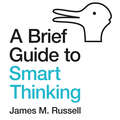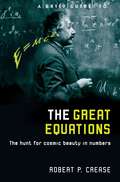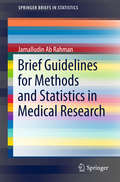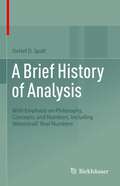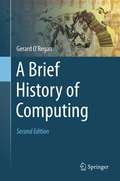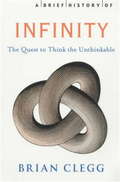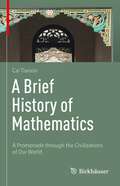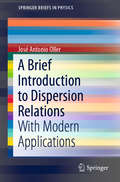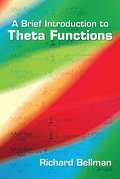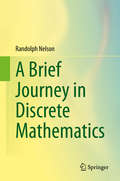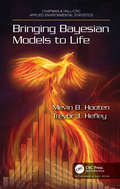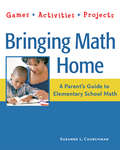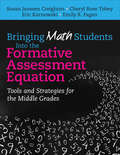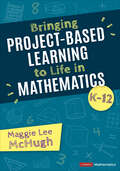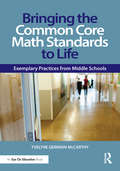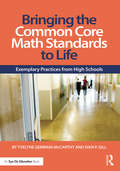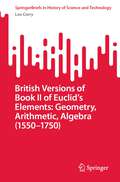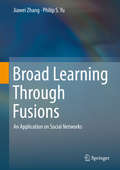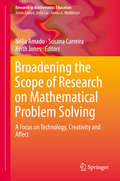- Table View
- List View
A Brief Guide to Smart Thinking: From Zeno's Paradoxes to Freakonomics
by James M. RussellEach book is summarised to convey a brief idea of what each one has to offer the interested reader, while a 'Speed Read' for each book delivers a quick sense of what each book is like to read and a highly compressed summary of the main points of the book in question. The titles covered include thought-provoking classics on psychology, mindfulness, rationality, the brain, mathematical and economic thought and practical philosophy. The selection includes books about self-improvement as well as historically interesting accounts of how the mind works. Titles included go back as far as the Epictetus classic The Enchiridion and Bertrand Russell's charming The ABC of Relativity, and proceed through classics such as Edward de Bono's Lateral Thinking and into the digital era with titles such as The Shallows and Big Data. The books are arranged chronologically, which draws attention to some of the interesting juxtapositions and connections between them. Some of the titles included are: Freakonomics, by Steven D. Levitt; Blink: The Power of Thinking Without Thinking, by Malcolm Gladwell; Sapiens: A Brief History of Humankind, by Yuval Noah Harari; The Organized Mind: Thinking Straight in the Age of Information Overload, by Daniel J. Levitin; The Descent of Man, by Grayson Perry; How the Mind Works, by Steven Pinker; Black Box Thinking: Why Some People Never Learn from Their Mistakes - But Some Do, by Matthew Syed; We Should All Be Feminists, by Chimamanda Ngozi Adichie; Guns, Germs, and Steel: The Fates of Human Societies, by Jared Diamond; The Black Swan: The Impact of the Highly Improbable, by Nassim Nicholas Taleb; Man's Search for Meaning, by Viktor E. Frankl; The News: A User's Manual, by Alain de Botton; Mindware: Tools for Smart Thinking, by Richard E. Nisbett; The ABC of Relativity, by Bertrand Russell; The Psychopath Test, by Jon Ronson; The Path: What Chinese Philosophers Can Teach Us About the Good Life, by Michael Puett; A Brief History of Time, by Stephen Hawking; Messy: The Power of Disorder to Transform Our Lives, by Tim Harford; Big Data: A Revolution That Will Transform How We Live, Work, and Think, by Viktor Mayer-Schönberger; Moneyball: The Art of Winning an Unfair Game, by Michael Lewis; The Survivors Club: The Secrets and Science That Could Save Your Life, by Ben Sherwood; Black Box Thinking, by Matthew Syed; Chaos: Making a New Science, by James Gleick; A Short History of Nearly Everything, by Bill Bryson; The Shallows: What the Internet Is Doing to Our Brains, by Nicholas Carr; Making Ideas Happen: Overcoming the Obstacles Between Vision and Reality, by Scott Belsky; The Enchiridion, by Epictetus; Gödel, Escher, Bach, by Douglas R. Hofstadter; What I Talk About When I Talk About Running, by Haruki Murakami; and Lateral Thinking, by Edward de Bono.
A Brief Guide to the Great Equations: The Hunt for Cosmic Beauty in Numbers (Brief Histories)
by Robert CreaseHere are the stories of the ten most popular equations of all time as voted for by readers of Physics World, including - accessibly described here for the first time - the favourite equation of all, Euler's equation.Each is an equation that captures with beautiful simplicity what can only be described clumsily in words. Euler's equation [eip + 1 = 0] was described by respondents as 'the most profound mathematic statement ever written', 'uncanny and sublime', 'filled with cosmic beauty' and 'mind-blowing'. Collectively these equations also amount to the world's most concise and reliable body of knowledge.Many scientists and those with a mathematical bent have a soft spot for equations. This book explains both why these ten equations are so beautiful and significant, and the human stories behind them.
Brief Guidelines for Methods and Statistics in Medical Research (SpringerBriefs in Statistics #0)
by Jamalludin Ab RahmanThis book serves as a practical guide to methods and statistics in medical research. It includes step-by-step instructions on using SPSS software for statistical analysis, as well as relevant examples to help those readers who are new to research in health and medical fields. Simple texts and diagrams are provided to help explain the concepts covered, and print screens for the statistical steps and the SPSS outputs are provided, together with interpretations and examples of how to report on findings. Brief Guidelines for Methods and Statistics in Medical Research offers a valuable quick reference guide for healthcare students and practitioners conducting research in health related fields, written in an accessible style.
A Brief History of Analysis: With Emphasis on Philosophy, Concepts, and Numbers, Including Weierstraß' Real Numbers
by Detlef D. SpaltThis book explores the origins of mathematical analysis in an accessible, clear, and precise manner. Concepts such as function, continuity, and convergence are presented with a unique historical point of view. In part, this is accomplished by investigating the impact of and connections between famous figures, like Newton, Leibniz, Johann Bernoulli, Euler, and more. Of particular note is the treatment of Karl Weierstraß, whose concept of real numbers has been frequently overlooked until now. By providing such a broad yet detailed survey, this book examines how analysis was formed, how it has changed over time, and how it continues to evolve today. A Brief History of Analysis will appeal to a wide audience of students, instructors, and researchers who are interested in discovering new historical perspectives on otherwise familiar mathematical ideas.
A Brief History of Computing
by Gerard O'ReganThis lively and fascinating text traces the key developments in computation - from 3000 B.C. to the present day - in an easy-to-follow and concise manner. Topics and features: ideal for self-study, offering many pedagogical features such as chapter-opening key topics, chapter introductions and summaries, exercises, and a glossary; presents detailed information on major figures in computing, such as Boole, Babbage, Shannon, Turing, Zuse and Von Neumann; reviews the history of software engineering and of programming languages, including syntax and semantics; discusses the progress of artificial intelligence, with extension to such key disciplines as philosophy, psychology, linguistics, neural networks and cybernetics; examines the impact on society of the introduction of the personal computer, the World Wide Web, and the development of mobile phone technology; follows the evolution of a number of major technology companies, including IBM, Microsoft and Apple.
A Brief History of Infinity: The Quest to Think the Unthinkable
by Brian Clegg'Space is big. Really big. You just won't believe how vastly, hugely, mind-bogglingly big it is. I mean, you may think it's a long way down the street to the chemist, but that's just peanuts to space.' Douglas Adams, Hitch-hiker's Guide to the GalaxyWe human beings have trouble with infinity - yet infinity is a surprisingly human subject. Philosophers and mathematicians have gone mad contemplating its nature and complexity - yet it is a concept routinely used by schoolchildren. Exploring the infinite is a journey into paradox. Here is a quantity that turns arithmetic on its head, making it feasible that 1 = 0. Here is a concept that enables us to cram as many extra guests as we like into an already full hotel. Most bizarrely of all, it is quite easy to show that there must be something bigger than infinity - when it surely should be the biggest thing that could possibly be. Brian Clegg takes us on a fascinating tour of that borderland between the extremely large and the ultimate that takes us from Archimedes, counting the grains of sand that would fill the universe, to the latest theories on the physical reality of the infinite. Full of unexpected delights, whether St Augustine contemplating the nature of creation, Newton and Leibniz battling over ownership of calculus, or Cantor struggling to publicise his vision of the transfinite, infinity's fascination is in the way it brings together the everyday and the extraordinary, prosaic daily life and the esoteric.Whether your interest in infinity is mathematical, philosophical, spiritual or just plain curious, this accessible book offers a stimulating and entertaining read.
A Brief History of Infinity: The Quest to Think the Unthinkable (Brief Histories)
by Brian Clegg'Space is big. Really big. You just won't believe how vastly, hugely, mind-bogglingly big it is. I mean, you may think it's a long way down the street to the chemist, but that's just peanuts to space.' Douglas Adams, Hitch-hiker's Guide to the GalaxyWe human beings have trouble with infinity - yet infinity is a surprisingly human subject. Philosophers and mathematicians have gone mad contemplating its nature and complexity - yet it is a concept routinely used by schoolchildren. Exploring the infinite is a journey into paradox. Here is a quantity that turns arithmetic on its head, making it feasible that 1 = 0. Here is a concept that enables us to cram as many extra guests as we like into an already full hotel. Most bizarrely of all, it is quite easy to show that there must be something bigger than infinity - when it surely should be the biggest thing that could possibly be. Brian Clegg takes us on a fascinating tour of that borderland between the extremely large and the ultimate that takes us from Archimedes, counting the grains of sand that would fill the universe, to the latest theories on the physical reality of the infinite. Full of unexpected delights, whether St Augustine contemplating the nature of creation, Newton and Leibniz battling over ownership of calculus, or Cantor struggling to publicise his vision of the transfinite, infinity's fascination is in the way it brings together the everyday and the extraordinary, prosaic daily life and the esoteric.Whether your interest in infinity is mathematical, philosophical, spiritual or just plain curious, this accessible book offers a stimulating and entertaining read.
A Brief History of Mathematical Thought: Key concepts and where they come from
by Luke HeatonMathematics is a product of human culture which has developed along with our attempts to comprehend the world around us. In A Brief History of Mathematical Thought, Luke Heaton explores how the language of mathematics has evolved over time, enabling new technologies and shaping the way people think. From stone-age rituals to algebra, calculus, and the concept of computation, Heaton shows the enormous influence of mathematics on science, philosophy and the broader human story.The book traces the fascinating history of mathematical practice, focusing on the impact of key conceptual innovations. Its structure of thirteen chapters split between four sections is dictated by a combination of historical and thematic considerations. In the first section, Heaton illuminates the fundamental concept of number. He begins with a speculative and rhetorical account of prehistoric rituals, before describing the practice of mathematics in Ancient Egypt, Babylon and Greece. He then examines the relationship between counting and the continuum of measurement, and explains how the rise of algebra has dramatically transformed our world. In the second section, he explores the origins of calculus and the conceptual shift that accompanied the birth of non-Euclidean geometries. In the third section, he examines the concept of the infinite and the fundamentals of formal logic. Finally, in section four, he considers the limits of formal proof, and the critical role of mathematics in our ongoing attempts to comprehend the world around us. The story of mathematics is fascinating in its own right, but Heaton does more than simply outline a history of mathematical ideas. More importantly, he shows clearly how the history and philosophy of maths provides an invaluable perspective on human nature.
A Brief History of Mathematical Thought: Key concepts and where they come from (Brief Histories)
by Luke HeatonMathematics is a product of human culture which has developed along with our attempts to comprehend the world around us. In A Brief History of Mathematical Thought, Luke Heaton explores how the language of mathematics has evolved over time, enabling new technologies and shaping the way people think. From stone-age rituals to algebra, calculus, and the concept of computation, Heaton shows the enormous influence of mathematics on science, philosophy and the broader human story.The book traces the fascinating history of mathematical practice, focusing on the impact of key conceptual innovations. Its structure of thirteen chapters split between four sections is dictated by a combination of historical and thematic considerations. In the first section, Heaton illuminates the fundamental concept of number. He begins with a speculative and rhetorical account of prehistoric rituals, before describing the practice of mathematics in Ancient Egypt, Babylon and Greece. He then examines the relationship between counting and the continuum of measurement, and explains how the rise of algebra has dramatically transformed our world. In the second section, he explores the origins of calculus and the conceptual shift that accompanied the birth of non-Euclidean geometries. In the third section, he examines the concept of the infinite and the fundamentals of formal logic. Finally, in section four, he considers the limits of formal proof, and the critical role of mathematics in our ongoing attempts to comprehend the world around us. The story of mathematics is fascinating in its own right, but Heaton does more than simply outline a history of mathematical ideas. More importantly, he shows clearly how the history and philosophy of maths provides an invaluable perspective on human nature.
A Brief History of Mathematics: A Promenade through the Civilizations of Our World
by Tianxin CaiThis volume, originally published in China and translated into four other languages, presents a fascinating and unique account of the history of mathematics, divided into eight chronologically organized chapters. Tracing the development of mathematics across disparate regions and peoples, with particular emphasis on the relationship between mathematics and civilization, it examines mathematical sources and inspirations leading from Egypt, Babylon and ancient Greece and expanding to include Chinese, Indian and Arabic mathematics, the European Renaissance and the French revolution up through the Nineteenth and Twentieth Centuries. Each chapter explores connections among mathematics and cultural elements of the time and place treated, accompanying the reader in a varied and exciting journey through human civilizations. The book contemplates the intersections of mathematics with other disciplines, including the relationship between modern mathematics and modern art, and the resulting applications, with the aid of images and photographs, often taken by the author, which further enhance the enjoyment for the reader. Written for a general audience, this book will be of interest to anyone who's studied mathematics in university or even high school, while also benefiting researchers in mathematics and the humanities.
A Brief Introduction to Dispersion Relations: With Modern Applications (SpringerBriefs in Physics)
by José Antonio OllerThis text offers a brief introduction to the dispersion relations as an approach to calculate S-matrix elements, a formalism that allows one to take advantage of the analytical structure of scattering amplitudes following the basic principles of unitarity and causality.First, the case of two-body scattering is considered and then its contribution to other processes through final-state interactions is discussed. For two-body scattering amplitudes, the general expression for a partial-wave amplitude is derived in the approximation where the crossed channel dynamics is neglected. This is taken as the starting point for many interesting nonperturbative applications, both in the light and heavy quark sector. Subsequently crossed channel dynamics is introduced within the equations for calculating the partial-wave amplitudes. Some applications based on methods that treat crossed-channel dynamics perturbatively are discussed too.The last part of this introductory treatment is dedicated to the further impact of scattering amplitudes on a variety of processes through final-state interactions. Several possible approaches are discussed such as the Muskhelishvili-Omnes dispersive integral equations and other closed formulae. These different formalisms are then applied in particular to the study of resonances presenting a number of challenging properties. The book ends with a chapter illustrating the use of dispersion relations in the nuclear medium for the evaluation of the energy density in nuclear matter.
A Brief Introduction to Theta Functions (Dover Books on Mathematics)
by Richard BellmanBrief but intriguing, this monograph on the theory of elliptic functions was written by one of America's most prominent and widely read mathematicians. Richard Bellman encompasses a wealth of material in a succession of short chapters, spotlighting high points of the fundamental regions of elliptic functions and illustrating powerful and versatile analytic methods. Suitable for advanced undergraduates and graduate students in mathematics, this introductory treatment is largely self-contained. Topics include Fourier series, sufficient conditions, the Laplace transform, results of Doetsch and Kober-Erdelyi, Gaussian sums, and Euler's formulas and functional equations. Additional subjects include partial fractions, mock theta functions, Hermite's method, convergence proof, elementary functional relations, multidimensional Poisson summation formula, the modular transformation, and many other areas.
A Brief Journey in Discrete Mathematics
by Randolph NelsonThe goal of this book is to showcase the beauty of mathematics as revealed in nine topics of discrete mathematics. In each chapter, properties are explored through a series of straightforward questions that terminate with results that lie at the doorstep of a field of study. Each step along the way is elementary and requires only algebraic manipulation. This frames the wonder of mathematics and highlights the complex world that lies behind a series of simple, mathematical, deductions. Topics addressed include combinatorics, unifying properties of symmetric functions, the Golden ratio as it leads to k-bonacci numbers, non-intuitive and surprising results found in a simple coin tossing game, the playful, trick question aspect of modular systems, exploration of basic properties of prime numbers and derivations of bewildering results that arise from approximating irrational numbers as continued fraction expansions. The Appendix contains the basic tools of mathematics that are used in the text along with a numerous list of identities that are derived in the body of the book. The mathematics in the book is derived from first principles. On only one occasion does it rely on a result not derived within the text. Since the book does not require calculus or advanced techniques, it should be accessible to advanced high school students and undergraduates in math or computer science. Senior mathematicians might be unfamiliar with some of the topics addressed in its pages or find interest in the book's unified approach to discrete math.
Bringing Bayesian Models to Life (Chapman & Hall/CRC Applied Environmental Statistics)
by Mevin B. Hooten Trevor J. HefleyBringing Bayesian Models to Life empowers the reader to extend, enhance, and implement statistical models for ecological and environmental data analysis. We open the black box and show the reader how to connect modern statistical models to computer algorithms. These algorithms allow the user to fit models that answer their scientific questions without needing to rely on automated Bayesian software. We show how to handcraft statistical models that are useful in ecological and environmental science including: linear and generalized linear models, spatial and time series models, occupancy and capture-recapture models, animal movement models, spatio-temporal models, and integrated population-models. Features: R code implementing algorithms to fit Bayesian models using real and simulated data examples. A comprehensive review of statistical models commonly used in ecological and environmental science. Overview of Bayesian computational methods such as importance sampling, MCMC, and HMC. Derivations of the necessary components to construct statistical algorithms from scratch. Bringing Bayesian Models to Life contains a comprehensive treatment of models and associated algorithms for fitting the models to data. We provide detailed and annotated R code in each chapter and apply it to fit each model we present to either real or simulated data for instructional purposes. Our code shows how to create every result and figure in the book so that readers can use and modify it for their own analyses. We provide all code and data in an organized set of directories available at the authors' websites.
Bringing Math Home: Games, Activities, Projects
by Suzanne ChurchmanThis ultimate parents' guide to elementary school math features projects, games, and activities children and parents can do together to increase their understanding of basic math concepts. Fun activities such as mapping a child's bedroom for practice in measurements or keeping a diary of numeric items like vacation mileage and expenses reinforce the math skills outlined in each lesson. Using the standards issued by the National Council of Teachers of Mathematics as a foundation, this book covers both content and process standards for areas such as algebra, geometry, measurement, problem solving, and reasoning/proofs. It also includes a glossary of math terms and dozens of suggestions for additional children's reading to further math understanding.
Bringing Math Students Into the Formative Assessment Equation: Tools and Strategies for the Middle Grades
by Cheryl Rose Tobey Emily R. Fagan Ms Susan Creighton Eric E. KarnowskiMake formative assessment work for you—and your math students! Finally, formative assessment that adds up! This research-based, teacher-tested guide, written specifically for middle school mathematics teachers, will help you teach more effectively and turn your students into self-regulated learners. As you implement instructional strategies, your students will start monitoring, assessing, and communicating about their own progress. Features include: A clear and manageable six-aspect instructional model Detailed strategies for helping students own their successes Real-life examples from middle school mathematics teachers Useful resources and a companion website to help you implement formative assessment in your classroom
Bringing Math Students Into the Formative Assessment Equation: Tools and Strategies for the Middle Grades
by Cheryl Rose Tobey Emily R. Fagan Ms Susan Creighton Eric E. KarnowskiMake formative assessment work for you—and your math students! Finally, formative assessment that adds up! This research-based, teacher-tested guide, written specifically for middle school mathematics teachers, will help you teach more effectively and turn your students into self-regulated learners. As you implement instructional strategies, your students will start monitoring, assessing, and communicating about their own progress. Features include: A clear and manageable six-aspect instructional model Detailed strategies for helping students own their successes Real-life examples from middle school mathematics teachers Useful resources and a companion website to help you implement formative assessment in your classroom
Bringing Out the Algebraic Character of Arithmetic: From Children's Ideas To Classroom Practice (Studies In Mathematical Thinking And Learning Ser.)
by Analúcia D. Schliemann David W. Carraher Bárbara M. BrizuelaBringing Out the Algebraic Character of Arithmetic contributes to a growing body of research relevant to efforts to make algebra an integral part of early mathematics instruction, an area of studies that has come to be known as Early Algebra. It provides both a rationale for promoting algebraic reasoning in the elementary school curriculum and empirical data to support it.The authors regard Early Algebra not as accelerated instruction but as an approach to existing topics in the early mathematics curriculum that highlights their algebraic character. Each chapter shows young learners engaged in mathematics tasks where there has been a shift away from computations on specific amounts toward thinking about relations and functional dependencies. The authors show how young learners attempt to work with mathematical generalizations before they have learned formal algebraic notation.The book, suitable as a text in undergraduate or graduate mathematics education courses, includes downloadable resources with additional text and video footage on how students reason about addition and subtraction as functions; on how students understand multiplication when it is presented as a function; and on how children use notations in algebraic problems involving fractions. These three videopapers (written text with embedded video footage) present relevant discussions that help identify students' mathematical reasoning. The printed text in the book includes transcriptions of the video episodes in the CD-ROM.Bringing Out the Algebraic Character of Arithmetic is aimed at researchers, practitioners, curriculum developers, policy makers and graduate students across the mathematics education community who wish to understand how young learners deal with algebra before they have learned about algebraic notation.
Bringing Project-Based Learning to Life in Mathematics, K-12 (Corwin Mathematics Series)
by Maggie Lee McHughGo beyond problem-solving and performance tasks. Bring project-based learning to life! Do you want your students to be more engaged in their mathematics lessons while also amplifying cultural relevancy and equity? If so, proceed to the next level of instruction with project-based learning (PBL)! This book provides the whole PBL game plan designed by an experienced, award-winning teacher and researcher. Whether you want to start with small steps or you are ready for full implementation in your classroom, project-based learning experiences can lead to forever memories and deeper learning for your students. Answering the why, what, and how of embarking on the journey toward PBL, readers will find Need-to-Know questions to open each chapter Student and educator vignettes to identify stumbling blocks and successes PBL Plus Tips that identify those small steps teachers can make to gradually shift toward PBL Your Turn prompts to actively connect ideas to your practice This approachable guide includes everything you need to move from tasks to memorable project-based experiences that leverage student voice and choice and build a welcoming classroom culture!
Bringing Project-Based Learning to Life in Mathematics, K-12 (Corwin Mathematics Series)
by Maggie Lee McHughGo beyond problem-solving and performance tasks. Bring project-based learning to life! Do you want your students to be more engaged in their mathematics lessons while also amplifying cultural relevancy and equity? If so, proceed to the next level of instruction with project-based learning (PBL)! This book provides the whole PBL game plan designed by an experienced, award-winning teacher and researcher. Whether you want to start with small steps or you are ready for full implementation in your classroom, project-based learning experiences can lead to forever memories and deeper learning for your students. Answering the why, what, and how of embarking on the journey toward PBL, readers will find Need-to-Know questions to open each chapter Student and educator vignettes to identify stumbling blocks and successes PBL Plus Tips that identify those small steps teachers can make to gradually shift toward PBL Your Turn prompts to actively connect ideas to your practice This approachable guide includes everything you need to move from tasks to memorable project-based experiences that leverage student voice and choice and build a welcoming classroom culture!
Bringing the Common Core Math Standards to Life: Exemplary Practices from Middle Schools
by Yvelyne Germain-McCarthyAs middle school math teachers shift to the Common Core State Standards, the question remains: What do the standards actually look like in the classroom? This book answers that question by taking you inside of real, Common Core classrooms across the country. You’ll see how exemplary teachers are meeting the new requirements and engaging students in math. Through these detailed examples of effective instruction, you will uncover how to bring the standards to life in your own classroom! Special Features:• A clear explanation of the big shifts happening in the classroom as a result of the Common Core State Standards • Real examples of how exemplary teachers are meeting the CCSS by teaching problem solving for different learning styles, proportional reasoning, the Pythagorean theorem, measurements, and more• A detailed analysis of each example to help you understand why it is effective and how you can try it with your own students• Practical, ready-to-use tools you can take back to your classroom, including unit plans and classroom handouts
Bringing the Common Core Math Standards to Life: Exemplary Practices from High Schools
by Yvelyne Germain-McCarthy Ivan GillAs high school math teachers shift to the Common Core State Standards, the question remains: What do the standards actually look like in the classroom? This book answers that question by taking you inside of real Common Core classrooms across the country. You’ll see how exemplary teachers are meeting the new requirements and engaging students in math. Through these detailed examples of effective instruction, you will uncover how to bring the standards to life in your own classroom! Special Features: A clear explanation of the big shifts happening in the classroom as a result of the Common Core State Standards Real examples of how exemplary teachers are using engaging strategies and tasks to teach algebra, geometry, trigonometry, statistics, mathematics across the curriculum, and moreA detailed analysis of each example to help you understand why it is effective and how you can try it with your own students Practical, ready-to-use tools you can take back to your classroom, including unit plans and classroom handouts
British Versions of Book II of Euclid’s Elements: Geometry, Arithmetic, Algebra (SpringerBriefs in History of Science and Technology)
by Leo CorryThis book discusses the changing conceptions about the relationship between geometry and arithmetic within the Euclidean tradition that developed in the British context of the sixteenth and seventeenth century. Its focus is on Book II of the Elements and the ways in which algebraic symbolism and methods, especially as recently introduced by François Viète and his followers, took center stage as mediators between the two realms, and thus offered new avenues to work out that relationship in idiosyncratic ways not found in earlier editions of the Euclidean text. Texts examined include Robert Recorde's Pathway to Knowledge (1551), Henry Billingsley’s first English translation of the Elements (1570), Clavis Mathematicae by William Oughtred and Artis Analyticae Praxis by Thomas Harriot (both published in 1631), Isaac Barrow’s versions of the Elements (1660), and John Wallis Treatise of Algebra (1685), and the English translations of Claude Dechales’ French Euclidean Elements (1685). This book offers a completely new perspective of the topic and analyzes mostly unexplored material. It will be of interest to historians of mathematics, mathematicians with an interest in history and historians of renaissance science in general.
Broad Learning Through Fusions: An Application on Social Networks
by Jiawei Zhang Philip S. YuThis book offers a clear and comprehensive introduction to broad learning, one of the novel learning problems studied in data mining and machine learning. Broad learning aims at fusing multiple large-scale information sources of diverse varieties together, and carrying out synergistic data mining tasks across these fused sources in one unified analytic. This book takes online social networks as an application example to introduce the latest alignment and knowledge discovery algorithms. Besides the overview of broad learning, machine learning and social network basics, specific topics covered in this book include network alignment, link prediction, community detection, information diffusion, viral marketing, and network embedding.
Broadening the Scope of Research on Mathematical Problem Solving: A Focus on Technology, Creativity and Affect (Research in Mathematics Education)
by Nélia Amado Susana Carreira Keith JonesThe innovative volume seeks to broaden the scope of research on mathematical problem solving in different educational environments. It brings together contributions not only from leading researchers, but also highlights collaborations with younger researchers to broadly explore mathematical problem-solving across many fields: mathematics education, psychology of education, technology education, mathematics popularization, and more. The volume’s three major themes—technology, creativity, and affect—represent key issues that are crucially embedded in the activity of problem solving in mathematics teaching and learning, both within the school setting and beyond the school. Through the book’s new pedagogical perspectives on these themes, it advances the field of research towards a more comprehensive approach on mathematical problem solving. Broadening the Scope of Research on Mathematical Problem Solving will prove to be a valuable resource for researchers and teachers interested in mathematical problem solving, as well as researchers and teachers interested in technology, creativity, and affect.
